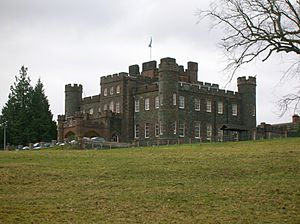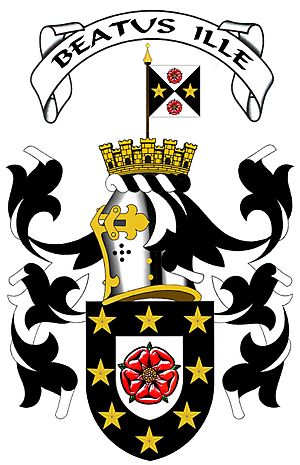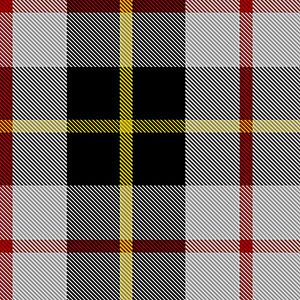Barony of Stobo facts for kids
The Barony of Stobo is a special area of land in Scotland, like a small lordship, named after Stobo Castle in the Scottish Borders. For nearly 500 years, this barony has been important in Scottish history. It was often connected to the powerful House of Stuart kings and queens. They would give or take away the barony to reward or punish people who were loyal to them.
Contents
The Barony's Beginnings
People believe the Barony of Stobo started around the 1100s. During this time, a powerful Anglo-Norman lord likely controlled the area. This lord had special rights, like being able to hold courts and collect taxes.
A person named Sir John Ker(r), also called the "Hunter of Swynhope," might have been an early Lord of Stobo around 1140. The Ker family came from Normandy, France. They were close to Hugh de Morville, a powerful Scottish lord. The Kerrs later became a well-known reiver clan, which means they were groups who raided across the border. The Marquesses of Lothian are descendants of this family.
A Look at Stobo's History
Church Influence and Royal Power
Around the 1100s, the Barony of Stobo came under the control of the Bishops of Glasgow. It might have been given to the Church by the Kerr family or the King. King David I was a very important king. He helped set up towns, markets, and new ways of government in Scotland. He also brought in the feudal system, where land was given in exchange for loyalty and service.
St Mungo’s church at Stobo was a very important church in the upper Tweed Valley during the early medieval period. In 1170, Pope Alexander III confirmed that the church belonged to the Bishop of Glasgow. This was confirmed many times over the next century. Stobo became a "prebend" of Glasgow Cathedral before 1266. This meant its income helped support a clergyman at the cathedral.
In 1369, 1482, and 1486, Stobo was listed as one of the baronies belonging to the Bishopric of Glasgow. Then, in 1489-90, King James IV of Scotland made Stobo a "free regality" for the Bishop of Glasgow. This gave the bishops a lot of power, almost like being a "little king" in their own area. It meant they were mostly beyond the reach of the King's officers.
Changes After the Reformation
The Reformation in Scotland brought big changes. The King took control of the barony from the Church. It was then given to James Douglas, 4th Earl of Morton. Morton was one of the four Regents of Scotland, ruling while King James VI was a child. King James VI later became King James I of England. Morton's time as Baron of Stobo was short. He was executed in 1581 for his part in the death of Henry Stuart, Lord Darnley, who was Mary, Queen of Scots' husband.
In 1587, the barony was given to Sir John Maitland. He was the Lord Chancellor of Scotland. He became the 1st Lord Maitland of Thirlestane in 1590. This was in thanks for his help in arranging the marriage of King James VI to Anne of Denmark. Maitland is seen as a key person in strengthening Stuart rule during this time.
Shifting Ownership and Royal Support
For the next 100 years, the barony changed hands between two groups who supported the Stuart kings. One group was Maitland's family, the powerful Earls of Lauderdale. They were leaders of Clan Maitland. The other group was the Dukes of Lennox and Richmond. They were close relatives of King James I, King Charles I, and King Charles II. A local family, the Tweedies of Dreva, also owned it briefly in the early 1600s.
In the 1630s, the Murrays, who were strong supporters of the Stuart kings, took over the barony. In 1664, King Charles II made them baronets for their loyalty. They became known as the Murrays of Stanhope. In 1697, Stobo was officially made a "free barony" by the King.
The Murrays lost everything because they supported the Jacobite cause. Sir David Murray, 4th Baronet, lost all his lands and titles for his part in the 1745 Rebellion. He died in another country in 1769.
The Barony is Forfeited
In 1767, James Montgomery bought Stobo for £40,000. He was the Lord Advocate of Scotland. He also bought a large and profitable share in land on Prince Edward Island in Canada. This money helped his son, the 2nd baronet, build Stobo Castle between 1805 and 1811. The new castle replaced an older fortified house. Sir James became a baronet in 1801.
The Barony of Stobo stayed with the Graham-Montgomery family until 1905. After that, it was owned by the Earls of Dysart until 1972.
The Main Place of the Barony
The main place, or "seat," of the Barony of Stobo is Stobo Castle. Since the mid-1970s, the castle and its grounds have been a luxury spa hotel. The large Stobo Estate, which was 3,884 acres, was divided and sold in late 2020.
The barony is in the historic area of Peeblesshire. Its southern edge runs along the north bank of the River Tweed. In 1740, a map showed that it covered about 7,000 acres. This included Stobo, West Dawyck, Easttoun and Westtoun, Dreva, and Muirburn.
Who Holds the Barony Now?
The Scottish Barony Register shows William Jolly as the current Baron of Stobo.
By tradition, the person who will inherit the barony is called the "baron baillie." They are also known as the Master of Muirburn. The small village of Muirburn has been part of the historic Stobo estate since at least the mid-1700s.
The baron's coat of arms is registered in the Public Register of All Arms and Bearings in Scotland. It is described as black, with a silver shield inside a border of eight gold stars. On the shield is a red rose with green leaves. The crest, which sits on top, is a banner with a silver and black cross. It also has two red roses and two gold stars.
A special tartan fabric has been designed for the current baron's heir, his family, and supporters. It is registered in the Scottish Register of Tartans. The barony is also linked to the Morton family of Douglas, which means the baron can wear the Black Douglas tartan.
A different tartan was registered in 2017 for the Stobo Castle spa hotel to use for business.





